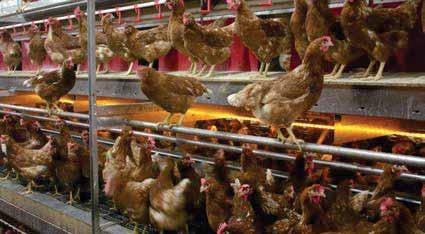
1 minute read
Light
Light
A properly lit house gives you a good overall view of the house and your hens. This applies to all types of housing systems. With floor systems, by distributing light throughout the living space and over time you can influence where the birds go and when, and whether they are active or rest. Day length and light intensity influence feed consumption and production.
Advertisement
Did you know that a hen...
sees more colours than humans in daylight? sees the light of conventional fluorescent tubes as flickering? This does not apply to high-frequency lamps, which are also more economical to run. prefers at least 60 lux for eating, drinking and scratching? prefers semi-darkness for egg laying and roosting: 0.5 to 1 lux? recognises others of their species better in more intensive light (> 70 lux)?
Pros and cons of lighting systems
Purchase price
Installation costs
Peripherals
Maintenance costs
Power consumption
Service life
Dimming
Light distribution
Spectrum display
Stroboscopic effect
Feather pecking/ cannibalism Incandescent lamp + +/+/--++ ++ + ++ + High-frequency fluorescent tube -+ +/+ ++ + ++ + +/++
Orion PL lamp* +/+ ++ + + ++ -++ ++ SL-lamp +/+/+ ++ + + ---
High-pressure sodium vapour lamp +/++ +/+ ++ ++ +/-+ +/++ = very good; + = good; +/- = average; - = poor; -- = very poor *In laying hen houses with the Orion PL system, one half consists of red lamps and the other half of white ones. LOOK THINKLOOK-THINK + copyright protected -ACT ACT
Dark spots?
There are dark spots in some places under the racks in this aviary house. The hens will want to lay their eggs there. If you want to avoid floor eggs there, fit rope lights, for example, as shown in this picture.











